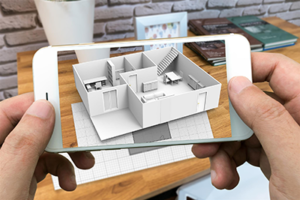 Augmented reality relies on three basic display types: Handheld devices such as mobile smartphones or portable computers, wearable technology or head mounted displays such as specially designed glasses or goggles (Google Glass application is one example; rumor also has it that a smart watch applying wearable technology is in construction by Apple.) and spatial displays which project computer enhanced graphics onto fixed surfaces.
Augmented reality relies on three basic display types: Handheld devices such as mobile smartphones or portable computers, wearable technology or head mounted displays such as specially designed glasses or goggles (Google Glass application is one example; rumor also has it that a smart watch applying wearable technology is in construction by Apple.) and spatial displays which project computer enhanced graphics onto fixed surfaces.
Although AR was most common to training simulation applications and video games at first, its uses have widened to a great degree in the last few years. At present, we can see uses of enhanced reality in many different fields and industries.
Military
HMD or head mounted displays are used extensively in military aircraft technology. With the help of the HMD, an aircraft pilot has all the data he needs, including airspeed, horizon line, altitude, etc., right before his eyes. So, there is no need for him to look down to the instrumentation board for the perusal of such data. AR applications and HMD facilities are used for many ground troops operations, too.
Tourism
Tourism industry also makes extensive use of enhanced reality in a bid to enrich the experience of the tourists and the sightseers. Museums, for example, have introduced interactive 3D live views of the museum artifacts. These shows help the visitors to the museum gain a deeper and more interactive knowledge about the displays and the attendant historical facts.
Medical
The medical field similarly looks to make good use of the 3D visualizations made possible through advancements in AR technology. Thanks to enhanced reality, medical students can now practice surgical operations in a controlled environment. Neurosurgical methods have especially benefited from the use of enhanced reality. Since brain surgeries are often very complex operations and the margins of errors are, in most cases, very small, the doctors benefit from having access to comprehensive 3D displays of the brain prior to the surgery.
Apart from these, we can also find extensive use of enhanced reality applications in many other fields such as navigation, gaming, entertainment, education, advertising & promotion, etc.
In the field of website design too, augmented or enhanced reality has made its effect felt in a big way. Especially, use of enhanced reality has become a big feature in web design for smartphones, tablet PCs, and other mobile devices. The application Layer Reality Browser, for example, which is available to Android and iPhone users, makes use of enhanced reality to retrieve data on structures, places, movies, and locations and displays these data as real-time digital information, thereby augmenting our view and experience of the real world. Loan Bird Studio, as a leading Asheville North Carolina. Web design solutions firm, incorporates augmented or enhanced reality applications in their website design and other solutions, whenever possible and relevant. The firm caters mainly to medium sized businesses and one can read more about their success stories from client testimonials posted at the company website www.lonebird.com, and at other relevant online platforms.


